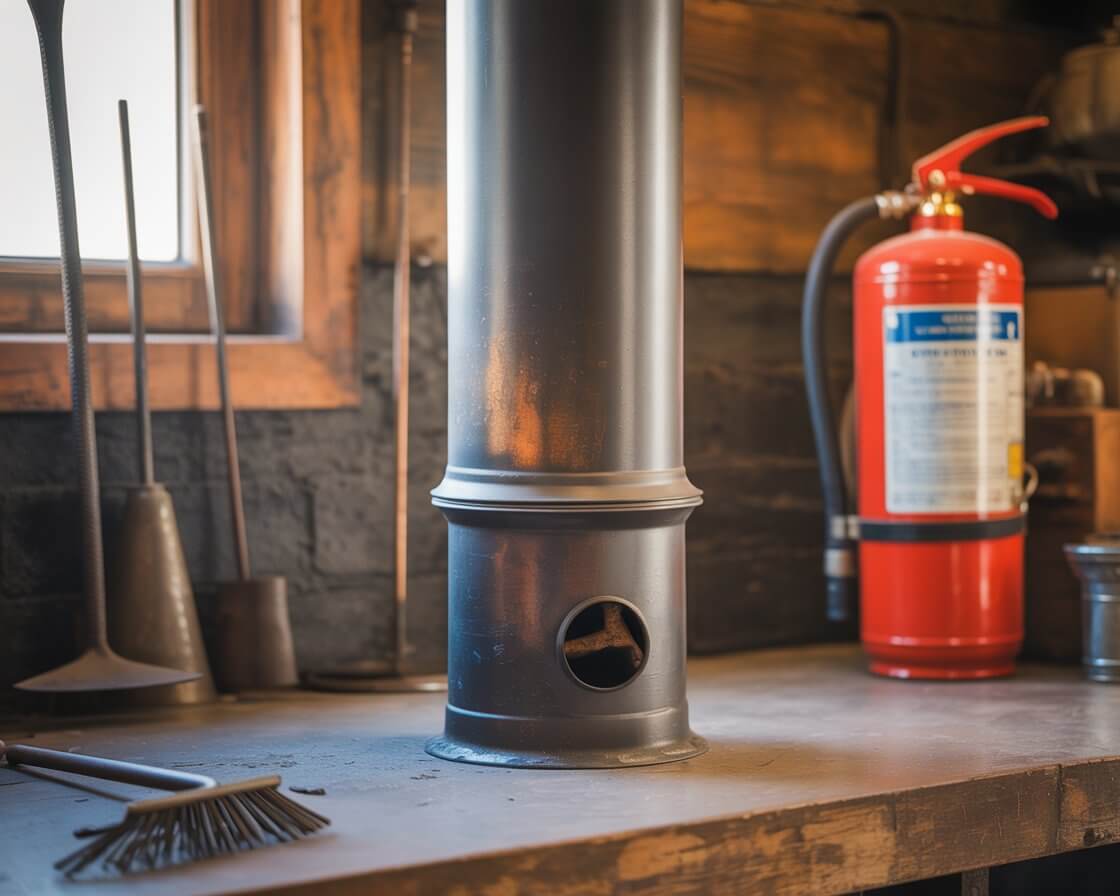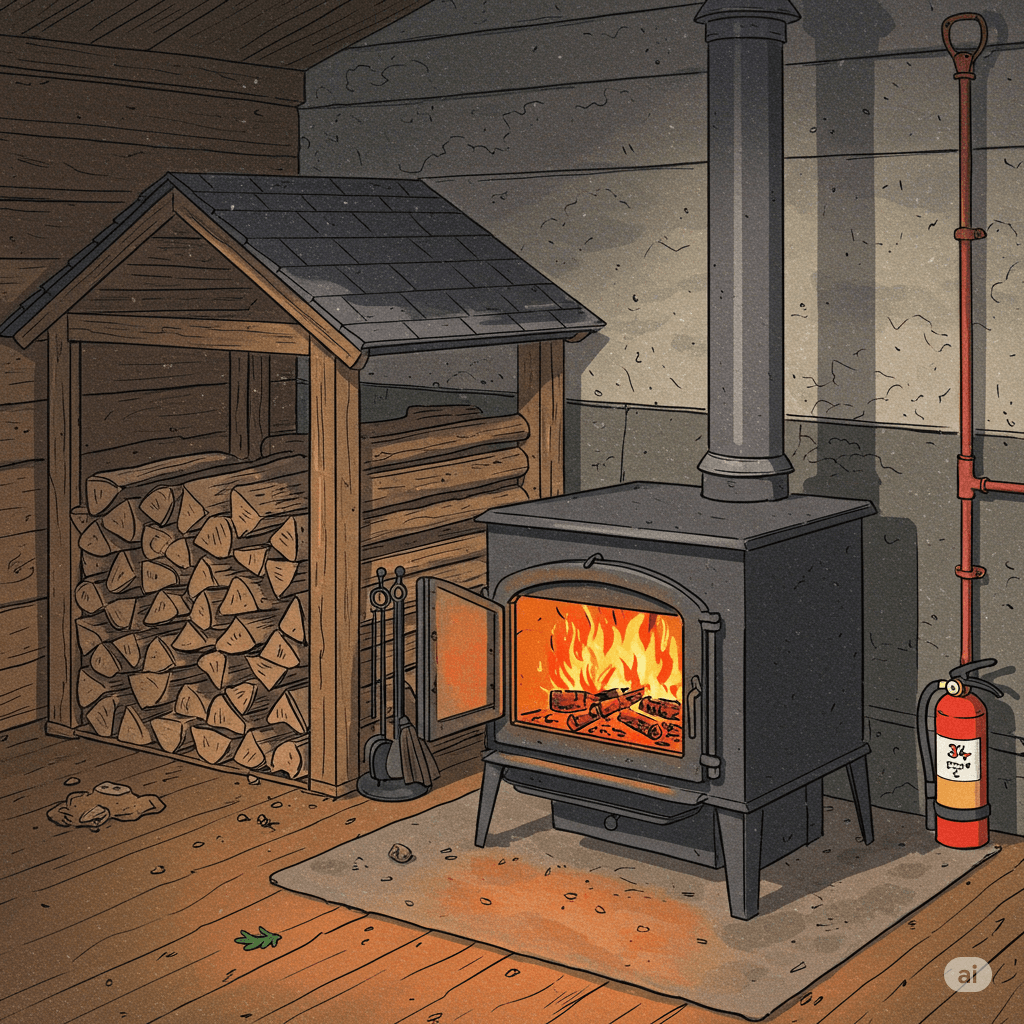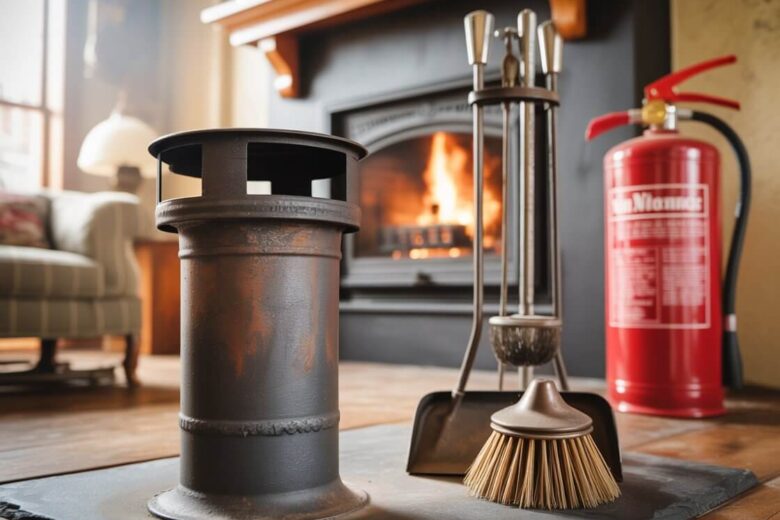Maintaining your wood stove pipe is a crucial task that should not be overlooked, especially as the colder months approach. Regular cleaning and maintenance help ensure your stove operates efficiently, provides consistent heat, and most importantly, keeps your home safe from potential fire hazards.
Neglecting your stove pipe can lead to dangerous creosote buildup, which is a leading cause of chimney fires. But the benefits of maintaining your wood stove pipe go beyond safety. Proper upkeep helps improve your stove’s performance, reduces smoke backups, and extends the overall lifespan of your stove system. Whether you’re a seasoned homeowner or new to wood heating, understanding the essential steps for stove pipe maintenance is key to getting the most out of your wood stove year-round.
Why Regular Stove Pipe Maintenance Is Crucial

Regular maintenance of your wood stove pipe isn’t just about keeping your system clean; it plays a vital role in ensuring safety, performance, and the longevity of your stove. Here’s why it’s essential to keep your stove pipe in top condition:
Preventing Chimney Fires: The Role of Creosote Buildup in Fire Hazards
One of the primary risks associated with a dirty stove pipe is creosote buildup. Creosote is a highly flammable substance that forms when wood is burned and unburned particles, along with moisture, condense on the walls of the chimney. Over time, this buildup can restrict airflow and increase the likelihood of a chimney fire. According to the NFPA (National Fire Protection Association), nearly 30% of all residential fires are linked to dirty chimneys, with creosote being the main culprit. Regular cleaning removes this dangerous buildup, reducing the risk of fires and ensuring your stove pipe stays safe and effective.
Improving Efficiency: How a Clean Stove Pipe Helps Your Wood Stove Perform Better
A clean stove pipe allows for better airflow and combustion. When your stove pipe is clogged with soot or creosote, the airflow is restricted, and your stove burns less efficiently. This means you’ll need to use more wood to achieve the same amount of heat. Regular cleaning ensures that your wood stove is running at optimal efficiency, providing more heat with less fuel, which not only saves you money but also reduces your environmental footprint.
Protecting Indoor Air Quality: Avoiding Smoke Backups and Toxic Fumes
Another significant benefit of maintaining a clean stove pipe is the improvement in indoor air quality. A dirty or clogged stove pipe can cause smoke to back up into your home, releasing harmful toxins like carbon monoxide and particulate matter. These toxic fumes can be dangerous to your health, especially if you have respiratory issues or young children in your home. Regular maintenance ensures that smoke flows freely out of your home, keeping the air clean and safe for everyone.
Extending Stove Lifespan: Reducing Wear on Your Stove and Pipe System
Over time, the buildup of creosote and soot can cause wear and tear on your stove’s components and the stove pipe itself. This can lead to expensive repairs or even the need to replace your stove entirely. By regularly cleaning your stove pipe and conducting annual inspections, you reduce the strain on your stove and pipe system, extending its lifespan and helping it perform better for years to come.
How Often Should You Clean Your Wood Stove Pipe?
Keeping your wood stove pipe clean is essential for maintaining a safe and efficient heating system. The frequency of cleaning depends on various factors, including usage, the type of wood burned, and professional recommendations. Let’s break down how often you should clean your stove pipe to keep it in top shape.

General Cleaning Guidelines: Recommendations from the CSIA and NFPA
According to both the Chimney Safety Institute of America (CSIA) and the National Fire Protection Association (NFPA), the general recommendation is to clean your stove pipe at least once a year. The CSIA and NFPA suggest scheduling a cleaning before the start of the heating season, typically in the fall, to remove any soot or creosote buildup that may have accumulated over time. These organizations also recommend hiring a certified chimney sweep to perform the cleaning if you’re unsure of the process, as they have the expertise and tools to ensure thorough cleaning and inspection.
Seasonal Considerations: Before Heating Season vs. Mid-Season Checks
While annual cleaning is important, it’s also a good idea to consider seasonal factors:
-
Before Heating Season: The best time to clean your stove pipe is before you start using it heavily in the colder months. Cleaning before you light your first fire ensures that your stove pipe is clear of any creosote or soot, which could otherwise pose a fire hazard. It also helps your stove run more efficiently, saving you both time and money throughout the season.
-
Mid-Season Checks: If you use your stove frequently, a mid-season check can be beneficial. During the colder months, creosote can build up more quickly, and a quick inspection halfway through the season ensures that your system remains safe and efficient. This is especially important if you notice any decrease in your stove’s performance.
Usage-Based Cleaning: How Frequently to Clean Based on Your Stove Use
The frequency of stove pipe cleaning may vary based on how often and how intensely you use your stove:
-
Heavy Use: If you use your stove daily or as your primary heat source, the stove pipe may need to be cleaned more often—every 2-3 months, depending on the amount of creosote buildup.
-
Occasional Use: If you only burn wood on weekends or during particularly cold weather, cleaning once per year is usually sufficient.
-
Types of Wood: The type of wood you burn can also affect how often cleaning is necessary. Burning seasoned firewood (wood with less than 20% moisture) produces less creosote compared to burning green or unseasoned wood, which can result in heavier buildup. If you burn green wood, you may need to clean your stove pipe more frequently.
Signs It’s Time for a Cleaning: Smell of Smoke, Poor Draft, Visible Soot
There are several telltale signs that indicate your stove pipe needs cleaning:
-
Smell of Smoke: If you start noticing a smoky smell inside your home, this could be a sign that your stove pipe is clogged, and smoke isn’t venting properly.
-
Poor Draft: A decrease in draft—when it becomes harder to light your fire or keep it burning—can also indicate a buildup of creosote inside the stove pipe.
-
Visible Soot: If you spot soot inside your stove or around the stove pipe, it’s a clear indication that the pipe needs cleaning. Signs of creosote buildup can also be spotted in the stove, and cleaning should be done immediately to prevent further accumulation.
By following these guidelines and paying attention to the signs of trouble, you can keep your wood stove pipe running safely and efficiently. Regular maintenance and cleaning will ensure you’re ready for each heating season and will protect your home from potential hazards.
Tools and Products for Effective Cleaning
Proper cleaning of your wood stove pipe requires the right tools and products to ensure safety, efficiency, and thoroughness. Here are the essential tools and products you’ll need for effective stove pipe maintenance:
Chimney Brush Kits: Choosing the Right Size and Type
One of the most essential tools for cleaning your stove pipe is a chimney brush. A chimney brush is designed to scrub the inside of the pipe, removing soot, creosote, and other debris that may have built up. When selecting a chimney brush kit, it’s important to choose the right size and type based on the diameter and shape of your stove pipe. Chimney brushes come in various sizes and materials—be sure to pick one that fits your specific stove pipe and the amount of cleaning required.
-
Brush Materials: Most chimney brushes are made from either nylon, steel, or poly bristles. Nylon brushes are suitable for light-duty cleaning, while steel-bristled brushes are ideal for more stubborn buildups.
-
Extension Rods: Many chimney brush kits come with extension rods, which allow you to reach higher sections of the stove pipe. Be sure to use high-quality rods that can handle the weight of the brush without breaking during use.
Inspection Mirrors & Rods: Ensuring Full Visibility Inside Your Stove Pipe
For a complete and safe cleaning, you need to inspect the inside of your stove pipe. Inspection mirrors and rods are tools designed to give you a clear view of the pipe’s interior without the need to disassemble it. These tools allow you to check for creosote buildup and any potential blockages before you begin cleaning. Some inspection mirrors are attached to telescoping rods, which extend into the pipe, making it easier to spot trouble spots from the outside. It’s crucial to inspect regularly, especially after a cleaning, to ensure that no buildup remains inside the pipe.
Creosote Removers: Chemical vs. Natural Options
Creosote removers are products specifically designed to break down the thick layers of creosote that can accumulate inside your stove pipe. These products help prevent the buildup of flammable materials, making it easier to clean your stove pipe thoroughly.
-
Chemical Options: There are a variety of chemical creosote removers available on the market. These are typically added directly to your firebox while burning your stove, causing creosote to break down and loosen, making cleaning easier. Some chemical products come in logs or sprays, and they are often effective at reducing buildup without requiring extensive scraping.
-
Natural Options: If you prefer a more eco-friendly approach, natural creosote removers are available. These products use ingredients like baking soda or other non-toxic substances to break down creosote. While they may take longer to work than chemical alternatives, they are an effective and safer option for people concerned about harsh chemicals.
Chimney Caps and Fire Extinguishers: Preventative Tools That Enhance Safety
Prevention is always better than cure when it comes to stove pipe maintenance, and there are a few tools that can help protect your home and enhance safety:
-
Chimney Caps: A chimney cap is a device that sits atop your chimney or stove pipe. It prevents debris, rain, snow, and animals from entering the pipe, which could cause blockages or fires. Chimney caps also help to reduce the amount of creosote buildup by regulating the airflow inside the chimney, which is essential for maintaining a clean and efficient stove pipe.
-
Fire Extinguishers: Having a fire extinguisher nearby is essential for ensuring safety when using your stove. It’s a good practice to have an extinguisher close to the stove to quickly respond to any potential fires. Be sure to keep the extinguisher properly maintained and in an accessible spot, especially during the heating season.
These tools and products will help you maintain your stove pipe and prevent the risks associated with improper cleaning or neglect. With the right equipment, you can safely keep your stove in optimal condition and enjoy its warmth year-round.
DIY vs. Professional Cleaning and Inspections
When it comes to maintaining your wood stove pipe, you have two options: do it yourself or hire a professional. Both methods have their benefits, but there are certain times when one approach is more appropriate than the other. Here’s a breakdown of what you need to know to make the best choice for your home and safety.
When to Call a Certified Chimney Sweep (CSIA): Benefits of Annual Professional Inspections
While regular cleaning can be done by homeowners, professional chimney sweeps are trained to thoroughly inspect and clean your stove pipe. The Chimney Safety Institute of America (CSIA) recommends an annual inspection by a certified professional to ensure that your stove pipe is free from hazardous buildup, structural damage, or other issues that may not be visible to the untrained eye.
Benefits of hiring a certified chimney sweep:
-
Thorough Inspection: A professional chimney sweep knows what to look for and can catch potential problems like cracks, rust, or dangerous buildup before they become serious issues.
-
Safety: Professionals have the proper tools and training to perform the cleaning safely, reducing the risk of accidents or injury.
-
Efficiency: A certified sweep can often clean your stove pipe more effectively than a DIY job, ensuring optimal airflow and safety.
DIY Maintenance Tips: Safe Methods Using Chimney Brush Kits
For homeowners who prefer to handle stove pipe maintenance themselves, a chimney brush kit is a must-have. If you choose the DIY route, make sure to follow these safety tips:
-
Choose the Right Tools: Be sure to select the appropriate size and type of chimney brush for your specific stove pipe. The brush should fit snugly inside the pipe to effectively remove soot and creosote.
-
Use Extension Rods: Many chimney brushes come with extension rods that allow you to reach higher areas of the pipe safely. Make sure you have a stable ladder and wear protective gloves to avoid injury.
-
Wear Safety Gear: Use safety glasses and a dust mask to protect your eyes and lungs from soot and debris during cleaning.
-
Follow Proper Cleaning Steps: Always start from the top of the chimney and work your way down. This ensures that debris falls safely and doesn’t block airflow. Make sure to remove all creosote and soot from the pipe to prevent buildup.
Common Mistakes to Avoid: Incomplete Cleaning, Using Wet Wood, or Skipping Inspections
While DIY cleaning can be effective, there are several common mistakes that homeowners often make:
-
Incomplete Cleaning: Not cleaning the entire stove pipe, including hard-to-reach areas, can leave dangerous creosote behind. Incomplete cleaning can result in fire hazards and decreased stove performance.
-
Using Wet Wood: Burning wet or unseasoned wood produces more smoke, which leads to faster creosote buildup in your stove pipe. Always burn seasoned firewood to reduce the risk of creosote.
-
Skipping Inspections: One of the biggest mistakes is neglecting regular inspections, especially if you’re doing the cleaning yourself. Even with regular cleaning, it’s essential to have an annual inspection by a certified professional to catch issues like cracks, leaks, or potential safety hazards.
Legal and Insurance Considerations: Documentation of Professional Cleanings
It’s important to note that some home insurance policies and local regulations may require proof of regular professional cleaning and inspection. Documentation of professional cleanings is crucial for:
-
Insurance Compliance: If you ever need to file an insurance claim related to fire damage or chimney issues, having records of professional inspections and cleanings may be necessary to meet your insurance company’s requirements.
-
Local Regulations: Some areas have local building codes or fire safety regulations that require homeowners to have their stove pipe cleaned and inspected annually by a certified professional.
Make sure to keep copies of all cleaning and inspection receipts, as they may be needed for insurance purposes or when selling your home.
Tips to Reduce Creosote Buildup and Fire Risk

Preventing creosote accumulation is one of the most effective ways to protect your home from chimney fires and ensure your wood stove operates safely. Here are some practical tips to reduce buildup and minimize fire risk:
Burn Seasoned Firewood Only: Why Moisture Content Matters
Using seasoned firewood—wood that has been dried for at least 6 to 12 months—is crucial for minimizing creosote buildup. Fresh or green wood contains high levels of moisture, which leads to incomplete combustion and cooler burning temperatures. This cooler smoke allows more creosote to condense inside your stove pipe.
-
Ideal Moisture Content: Firewood should have a moisture content below 20%. You can use a moisture meter to check your wood before burning.
-
Storage Tips: Stack firewood in a dry, well-ventilated area, off the ground, and covered on top to allow proper seasoning.
Keep Fires Hot, Not Smoldering: How Proper Airflow Reduces Buildup
A hot, well-ventilated fire helps ensure complete combustion, which means less smoke and fewer creosote-forming particles. Smoldering or slow-burning fires often occur when airflow is restricted, or when using damp wood.
-
Open the Damper Fully: Always start fires with the damper wide open to allow maximum airflow.
-
Add Smaller Logs First: Begin with kindling and smaller logs to get the fire hot quickly before adding larger pieces.
-
Avoid Overloading the Stove: Too much wood can choke airflow and cause smoldering conditions.
Install a Chimney Cap: Prevents Debris, Rain, and Animals
A chimney cap is a simple yet effective tool for preventing creosote buildup and fire hazards. It sits atop your stove pipe or chimney and offers several safety benefits:
-
Keeps Out Moisture: Rain and snow can mix with soot and ash inside your stove pipe, accelerating creosote buildup.
-
Prevents Blockages: A chimney cap keeps out leaves, twigs, and nesting animals that could block airflow and increase fire risk.
-
Improves Draft: Some chimney caps are designed to improve draft and prevent downdrafts that can push smoke into your home.
Ensure Safe Clearance Around Stove: Maintain 3 Feet from Combustibles
The area surrounding your wood stove must be free of flammable materials to reduce the risk of fire. Even small embers or radiant heat from the stove can ignite nearby objects if placed too close.
-
Maintain a 3-Foot Clearance: Keep furniture, curtains, books, and other combustibles at least three feet away from the stove.
-
Install Heat Shields if Needed: For tight spaces, consider installing a wall heat shield to reduce required clearance.
-
Have a Fire Extinguisher Handy: Always keep a Class A/B/C fire extinguisher nearby and ensure everyone in the household knows how to use it.

